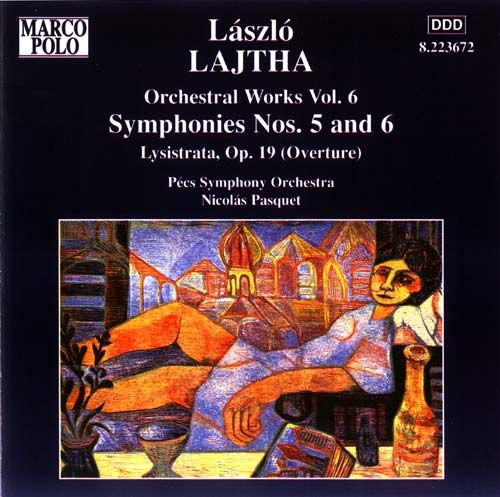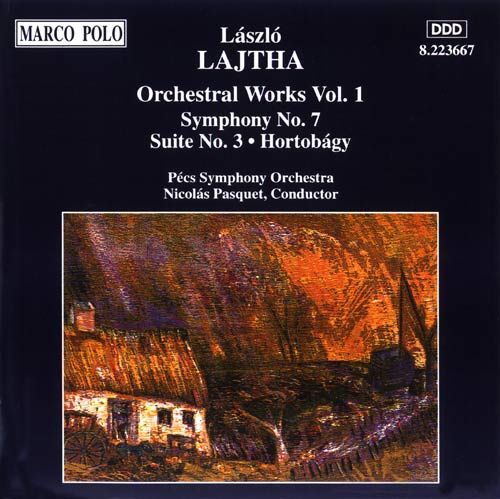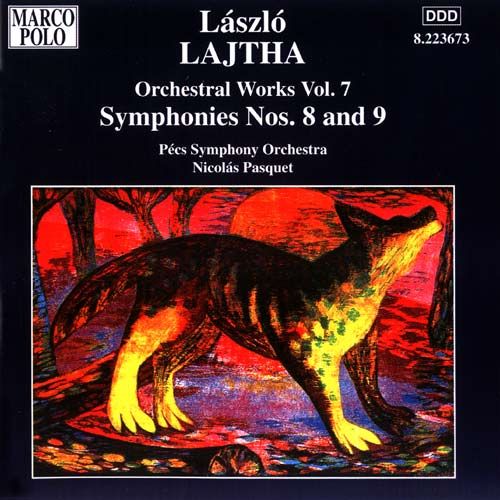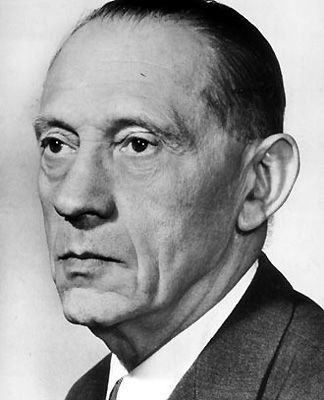wimpel69
02-16-2013, 02:31 PM
Sharing on this item has ended. Link is dead.!
L�szl� Lajtha (1892-1963)
Complete Symphonies & Misc. Orchestral Works
Genre: Symphonic
Style: "Klassische Moderne" (moderately advanced tonality)
L�szl� Lajtha was a Hungarian composer, ethnomusicologist and conductor. Born to Ida Wiesel, a Transsylvanian-Hungarian
with some Saxon-German ancestry as the name Wiesel indicates and P�l Lajtha, an owner of a leather factory. The father P�l had
ambitions to become a conductor, played the violin well and also composed. Lajtha studied with Viktor Herzfeld in the Academy of
Music in that city and then in Leipzig, Geneva and finally Paris where he was a pupil of Vincent d'Indy. Before the First World War,
in collaboration with B�la Bart�k and Zolt�n Kod�ly, he undertook the study and transcription of Hungarian folk song, heading up a
project to produce a series of folk music recordings. Throughout the war he served at the front as an artillery officer, an experience
recalled in his sombre Second Symphony (1938) – a work that remained unperformed until 1988. In 1919 he began teaching at the
Budapest National Conservatory. (Among his pupils was the conductor J�nos Ferencsik, who was later one of the principal champions
of his music.) From 1928 he was a member of the International Commission of Popular Arts and Traditions.
Lajtha composed in a moderately advanced tonal idiom that betrays his Hungarian roots, not far removed from the style of
Mikl�s R�zsa, albeit somewhat less Germanic. Chances are that if you like R�zsa's orchestral works, and his film music,
you'll like Lajtha's, too (Amusingly, All Music have a portrait photo of Lajtha's on their website, which very clearly shows the young R�zsa!!!:
L�szl� Lajtha - Music Biography, Credits and Discography : AllMusic (http://www.allmusic.com/artist/l%C3%A1szl%C3%B3-lajtha-mn0002051191))
Included in this upload are the complete symphonies (9), as well as the following shorter works/excerpts:
Orchestral Suite No.1
Orchestral Suite No.2
Orchestral Suite No.3
Hortob�gy (excerpts)
Overture to "Lysistrata"
Variations for Orchestra
In Memoriam






Music Composed by L�szl� Lajtha
Played by the P�cs Symphony Orchestra
Conducted by Nicol�s Pasquet
"Just when you think you've got the all the necessary statues set in the Pantheon, something tells you that you may need
to add a wing. Liszt, Bart�k, and Kod�ly already stand in the Hungarian room, with Dohn�nyi and R�sza (if I had a vote) waiting
in the wings. Roughly ten years younger than either Bart�k or Kod�ly, L�szl� Lajtha studied composition in Budapest and got
swept up in the folk-music collection movement. His music strikes me as a combination of both the older men, but it has less
of an air of experimentation. The battle for intellectual acceptance of Modernism seems over. Apparently, the age gap made
a difference, as it did for Mikl�s R�zsa, born fifteen years after Lajtha. Lajtha uses the shapes of Hungarian folk music, not for
nationalist reasons, but because he seems to like them. His music has as much affinity with composers in Paris as in Hungary.
Like Bart�k, his music is primarily contrapuntal. Unlike Bart�k, classical forms attract him. He wrote, for example, nine
symphonies to Bart�k's none. The symphonies occupy a central place in his catalogue, although he also turned out ballet
scores and a ton of chamber music, including ten string quartets.
Bad breaks plagued Lajtha's career. Scores have been lost. Major works remain unperformed, even in Hungary, initially due to
the conservatism of Hungarian musical circles between the wars. World War II interrupted it, and the post-war Communist
government made trouble for him, usually in the name of Socialist Realism. Like Shostakovich in the Soviet Union, the government
cast Lajtha in the antipodal roles of honored artist-hero and bourgeois apostate. They gave him medals and took away and
restored teaching positions at their whim. When his music did make it to the West, it was usually well received (his Third Quartet
won a Coolidge Prize), but it never got enough of a grip. Within Hungary, his pupil, conductor J�nos Ferencsik, championed his work.
The Suite #2 comes from a ballet, Le bosquet des quatre dieux (1943), never performed as a whole. Listening to the Suite,
I wonder what in heaven's name the impresarios heard. Joyful and light, somewhat in the vein of Bart�k's Rumanian Dances
or Kod�ly's H�ry J�nos Suite. The plot really doesn't matter, although the liner notes go into it in some detail. The music
works all on its own, without literary or visual aids. The first movement is full of fanfares, with a restless movement that
puts one in mind of Martinů. The second movement, a vivacious perpetuum mobile that occasionally stops for breath, sparkles
in mostly delicate orchestration, with the occasional muscle of brass. A heartfelt serenade in the manner of Kod�ly conjures
up the lonely, wind-swept Hungarian plains. The finale switches among march, jig, and foxtrot, with an orchestration that
emphasizes rapid color changes. Although designated a suite, it runs miles beyond most others. Lajtha could just as easily
have called it a symphony, but for a tender artistic conscience. At one point, a startling foreshadowing of Bart�k's "Game of
Couples" from the Concerto for Orchestra peeks out.
In the late Forties, before the Communist takeover, Lajtha found himself in London with a commission to write a score
for a filmed version of T. S. Eliot's Murder in the Cathedral. I have never seen this film. I tried looking it up for a rental but
struck out. According to the Internet, the British National Film Library has one copy. Talk about a cult classic. At any rate,
Lajtha recycled some of the score into his Third Symphony (1947). The dread of the play carries over into the symphony,
which consists of two longish movements – the first slow, the second fast. The first movement begins with a clarinet alone
for about a minute-and-a-half. Strings enter unison. Much of the movement proceeds in two parts, with two extended
lines spinning against each other. I picked out five distinct ideas, but I'm willing to bet that some are related. Lajtha
concentrates on two: the opening clarinet solo, beginning with a rising semitone and an upward leap of a third, and the
string idea, beginning with an upward leap of a sixth. The former uses a "fadeaway" gesture, reminiscent of the sagging
flutes at the beginning of Bart�k's Concerto for Orchestra. The latter gets singled out for extensive imitative, contrapuntal
treatment. Along the way, you also get lines evocative of plainchant. The movement is mainly quiet, never rising above a
mezzo forte, and it ends quietly, with violin and flute solos.
The finale begins with a call to arms. Oddly, in its restless undercurrent, it sounds like an update of Bruckner. Most of
the themes vary ideas in the first movement, including the two main ones. A memorable gesture occurs with heavy staccato
brass chords, off the beat, throughout, as well as at the close. In terms of movies, it's the sort of music that ratchets up
tension during pursuit. Throughout the symphony, however, Lajtha builds a tight, truly symphonic argument, rather than
merely strings cues together. In its balance of architecture and emotion, it makes a great impression.
The Fourth Symphony comes from the early Fifties, when Lajtha found himself under an official cloud. Critics attacked
him with the usual Socialist Realism nonsense (or its Hungarian equivalent), both laughable and aggravating to read today.
Socialist Realism has nothing to do with aesthetics, although its practitioners direct it at works of art. It completely concerns
political control and bolsters the massive, arbitrary power of the state. That such a joyful, clear-cut work (it lives up to its
subtitle "Spring") could attract such brickbats shows the aesthetic emptiness and political prostitution of many Eastern
European intellectuals – and not a few Western ones as well.
The work has three fast or moderately fast movements: "Allegro molto," "Allegretto," "Vivace." The first movement begins as a
perpetuum mobile, with a constant substrata of quick notes. It displays an unusual shape, having nothing to do with
classical forms. The first part of the movement plays with four musical cells, avoiding sonata in favor of a mosaic. These cells
often act like thematic mottos – from their heads spring new tails. About halfway through, the quick notes fade out in favor
of a lyrical, yearning idea, which takes us pretty much to the end, marked by quiet and a gorgeous violin solo. The "Allegretto"
is a melancholy minuet, sounding initially like the "Callot" movement in Mahler's First, just to give you some idea of the emotional
neighborhood. Bart�k references float through – the Concerto for Orchestra's "Interrupted Serenade" and the First Portrait
among them. The finale, which begins as a vivid gigue, gets the body moving. It proceeds mainly by the uncoiling of a contrapuntal
spring. The orchestration is mostly spare and serves color changes rather than mass, although Lajtha does drop the hammer
at climactic points. Occasionally, popular themes, possibly French, bubble to the surface. Other rhythms, including a Hungarian
rondo, knock out the gigue as the movement goes along, and finally we wind up with the opening theme of the entire symphony.
The end is a joke I won't spoil.
Pasquet and the P�cs make a strong case for Lajtha, despite occasional raggedness. I noticed it only because Lajtha is so
contrapuntally precise. How an orchestra like the Berlin would do with sufficient commitment, I can't imagine. Even so, Pasquet
and his players have committed. They give you understanding, animated readings of a composer without a deep performing
tradition."
Classical Net (Review of Symphonies 3 & 4 )


Source: Marco Polo CDs (my rips)
Format: mp3, 320k/s (CBR), DDD Stereo
File Size: 1.09 GB
[b]Sharing on this item has ended. Link is dead.!
L�szl� Lajtha (1892-1963)
Complete Symphonies & Misc. Orchestral Works
Genre: Symphonic
Style: "Klassische Moderne" (moderately advanced tonality)
L�szl� Lajtha was a Hungarian composer, ethnomusicologist and conductor. Born to Ida Wiesel, a Transsylvanian-Hungarian
with some Saxon-German ancestry as the name Wiesel indicates and P�l Lajtha, an owner of a leather factory. The father P�l had
ambitions to become a conductor, played the violin well and also composed. Lajtha studied with Viktor Herzfeld in the Academy of
Music in that city and then in Leipzig, Geneva and finally Paris where he was a pupil of Vincent d'Indy. Before the First World War,
in collaboration with B�la Bart�k and Zolt�n Kod�ly, he undertook the study and transcription of Hungarian folk song, heading up a
project to produce a series of folk music recordings. Throughout the war he served at the front as an artillery officer, an experience
recalled in his sombre Second Symphony (1938) – a work that remained unperformed until 1988. In 1919 he began teaching at the
Budapest National Conservatory. (Among his pupils was the conductor J�nos Ferencsik, who was later one of the principal champions
of his music.) From 1928 he was a member of the International Commission of Popular Arts and Traditions.
Lajtha composed in a moderately advanced tonal idiom that betrays his Hungarian roots, not far removed from the style of
Mikl�s R�zsa, albeit somewhat less Germanic. Chances are that if you like R�zsa's orchestral works, and his film music,
you'll like Lajtha's, too (Amusingly, All Music have a portrait photo of Lajtha's on their website, which very clearly shows the young R�zsa!!!:
L�szl� Lajtha - Music Biography, Credits and Discography : AllMusic (http://www.allmusic.com/artist/l%C3%A1szl%C3%B3-lajtha-mn0002051191))
Included in this upload are the complete symphonies (9), as well as the following shorter works/excerpts:
Orchestral Suite No.1
Orchestral Suite No.2
Orchestral Suite No.3
Hortob�gy (excerpts)
Overture to "Lysistrata"
Variations for Orchestra
In Memoriam






Music Composed by L�szl� Lajtha
Played by the P�cs Symphony Orchestra
Conducted by Nicol�s Pasquet
"Just when you think you've got the all the necessary statues set in the Pantheon, something tells you that you may need
to add a wing. Liszt, Bart�k, and Kod�ly already stand in the Hungarian room, with Dohn�nyi and R�sza (if I had a vote) waiting
in the wings. Roughly ten years younger than either Bart�k or Kod�ly, L�szl� Lajtha studied composition in Budapest and got
swept up in the folk-music collection movement. His music strikes me as a combination of both the older men, but it has less
of an air of experimentation. The battle for intellectual acceptance of Modernism seems over. Apparently, the age gap made
a difference, as it did for Mikl�s R�zsa, born fifteen years after Lajtha. Lajtha uses the shapes of Hungarian folk music, not for
nationalist reasons, but because he seems to like them. His music has as much affinity with composers in Paris as in Hungary.
Like Bart�k, his music is primarily contrapuntal. Unlike Bart�k, classical forms attract him. He wrote, for example, nine
symphonies to Bart�k's none. The symphonies occupy a central place in his catalogue, although he also turned out ballet
scores and a ton of chamber music, including ten string quartets.
Bad breaks plagued Lajtha's career. Scores have been lost. Major works remain unperformed, even in Hungary, initially due to
the conservatism of Hungarian musical circles between the wars. World War II interrupted it, and the post-war Communist
government made trouble for him, usually in the name of Socialist Realism. Like Shostakovich in the Soviet Union, the government
cast Lajtha in the antipodal roles of honored artist-hero and bourgeois apostate. They gave him medals and took away and
restored teaching positions at their whim. When his music did make it to the West, it was usually well received (his Third Quartet
won a Coolidge Prize), but it never got enough of a grip. Within Hungary, his pupil, conductor J�nos Ferencsik, championed his work.
The Suite #2 comes from a ballet, Le bosquet des quatre dieux (1943), never performed as a whole. Listening to the Suite,
I wonder what in heaven's name the impresarios heard. Joyful and light, somewhat in the vein of Bart�k's Rumanian Dances
or Kod�ly's H�ry J�nos Suite. The plot really doesn't matter, although the liner notes go into it in some detail. The music
works all on its own, without literary or visual aids. The first movement is full of fanfares, with a restless movement that
puts one in mind of Martinů. The second movement, a vivacious perpetuum mobile that occasionally stops for breath, sparkles
in mostly delicate orchestration, with the occasional muscle of brass. A heartfelt serenade in the manner of Kod�ly conjures
up the lonely, wind-swept Hungarian plains. The finale switches among march, jig, and foxtrot, with an orchestration that
emphasizes rapid color changes. Although designated a suite, it runs miles beyond most others. Lajtha could just as easily
have called it a symphony, but for a tender artistic conscience. At one point, a startling foreshadowing of Bart�k's "Game of
Couples" from the Concerto for Orchestra peeks out.
In the late Forties, before the Communist takeover, Lajtha found himself in London with a commission to write a score
for a filmed version of T. S. Eliot's Murder in the Cathedral. I have never seen this film. I tried looking it up for a rental but
struck out. According to the Internet, the British National Film Library has one copy. Talk about a cult classic. At any rate,
Lajtha recycled some of the score into his Third Symphony (1947). The dread of the play carries over into the symphony,
which consists of two longish movements – the first slow, the second fast. The first movement begins with a clarinet alone
for about a minute-and-a-half. Strings enter unison. Much of the movement proceeds in two parts, with two extended
lines spinning against each other. I picked out five distinct ideas, but I'm willing to bet that some are related. Lajtha
concentrates on two: the opening clarinet solo, beginning with a rising semitone and an upward leap of a third, and the
string idea, beginning with an upward leap of a sixth. The former uses a "fadeaway" gesture, reminiscent of the sagging
flutes at the beginning of Bart�k's Concerto for Orchestra. The latter gets singled out for extensive imitative, contrapuntal
treatment. Along the way, you also get lines evocative of plainchant. The movement is mainly quiet, never rising above a
mezzo forte, and it ends quietly, with violin and flute solos.
The finale begins with a call to arms. Oddly, in its restless undercurrent, it sounds like an update of Bruckner. Most of
the themes vary ideas in the first movement, including the two main ones. A memorable gesture occurs with heavy staccato
brass chords, off the beat, throughout, as well as at the close. In terms of movies, it's the sort of music that ratchets up
tension during pursuit. Throughout the symphony, however, Lajtha builds a tight, truly symphonic argument, rather than
merely strings cues together. In its balance of architecture and emotion, it makes a great impression.
The Fourth Symphony comes from the early Fifties, when Lajtha found himself under an official cloud. Critics attacked
him with the usual Socialist Realism nonsense (or its Hungarian equivalent), both laughable and aggravating to read today.
Socialist Realism has nothing to do with aesthetics, although its practitioners direct it at works of art. It completely concerns
political control and bolsters the massive, arbitrary power of the state. That such a joyful, clear-cut work (it lives up to its
subtitle "Spring") could attract such brickbats shows the aesthetic emptiness and political prostitution of many Eastern
European intellectuals – and not a few Western ones as well.
The work has three fast or moderately fast movements: "Allegro molto," "Allegretto," "Vivace." The first movement begins as a
perpetuum mobile, with a constant substrata of quick notes. It displays an unusual shape, having nothing to do with
classical forms. The first part of the movement plays with four musical cells, avoiding sonata in favor of a mosaic. These cells
often act like thematic mottos – from their heads spring new tails. About halfway through, the quick notes fade out in favor
of a lyrical, yearning idea, which takes us pretty much to the end, marked by quiet and a gorgeous violin solo. The "Allegretto"
is a melancholy minuet, sounding initially like the "Callot" movement in Mahler's First, just to give you some idea of the emotional
neighborhood. Bart�k references float through – the Concerto for Orchestra's "Interrupted Serenade" and the First Portrait
among them. The finale, which begins as a vivid gigue, gets the body moving. It proceeds mainly by the uncoiling of a contrapuntal
spring. The orchestration is mostly spare and serves color changes rather than mass, although Lajtha does drop the hammer
at climactic points. Occasionally, popular themes, possibly French, bubble to the surface. Other rhythms, including a Hungarian
rondo, knock out the gigue as the movement goes along, and finally we wind up with the opening theme of the entire symphony.
The end is a joke I won't spoil.
Pasquet and the P�cs make a strong case for Lajtha, despite occasional raggedness. I noticed it only because Lajtha is so
contrapuntally precise. How an orchestra like the Berlin would do with sufficient commitment, I can't imagine. Even so, Pasquet
and his players have committed. They give you understanding, animated readings of a composer without a deep performing
tradition."
Classical Net (Review of Symphonies 3 & 4 )


Source: Marco Polo CDs (my rips)
Format: mp3, 320k/s (CBR), DDD Stereo
File Size: 1.09 GB
[b]Sharing on this item has ended. Link is dead.!
